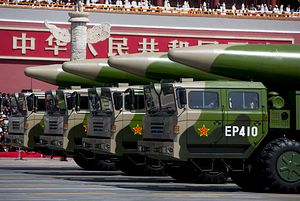On August 2, the Intermediate Range Nuclear Forces Treaty (INF), a bilateral arms control treaty originally signed between the United States and the Soviet Union (now Russia), will end. U.S. President Donald Trump had announced the U.S. withdrawal from the Treaty six months back, and the withdrawal period is about to end.
While the focus of the INF Treaty itself was on the United States and Russia, is likely to have a much broader impact than just between the two countries. The INF Treaty was seen as having the ability to bring about a semblance of stability much beyond Washington and Moscow. Now there are growing concerns that this will give rise to a new arms race.
The 1987 INF Treaty saw the United States and the Soviet Union agree to remove an entire class of weapons – nuclear and conventional ground-launched ballistic and cruise missiles with ranges between 500 and 5,500 kilometers, including Soviet SS-20s and the U.S. ground-launched cruise missiles (GLCMs) and Pershing II ballistic missiles. Based on the commitments made in the treaty, the two countries destroyed a total of 2,692 short-, medium-, and intermediate-range missiles by June 1, 1991, the treaty implementation deadline. This is the only nuclear arms control treaty that eliminated an entire class of existing weapons.
The Trump announcement of the U.S. intent to leave the treaty came about after repeated reports of Russian breaches of its INF commitments. The Russian breaches are not new. The complaints had been around under the Obama administration, for instance, when Russia developed a new cruise missile, the 9M729 (NATO name: SSC-8). NATO has also remained concerned about the treaty breaches. In fact, NATO Secretary-General Jens Stoltenberg stated that “the ‘ongoing Russian violation’ was the only reason the 1987 treaty was under threat.”
Russia of course denied that they were violating any commitment made under the INF Treaty. A senior Russian official is reported to have said that it is not in violation of any commitment and that the missile 9M729 is within the INF range limit of 500 kilometers. In fact, a Russian commander, General Mikhail Matveyevsky has reportedly stated that its maximum flight range is 480 km.
There are concerns within the United States and outside about the impact of the treaty withdrawal. U.S. Senator Bob Menendez (a Democrat from New Jersey), the ranking member on the Senate Foreign Relations Committee, has said that withdrawing without a follow-on treaty taking the place of the INF is a recipe for an arms race. Menendez argues that “Russia will clearly spend money on updating and amplifying its weapons systems.”
Yes, Russia might respond by building more INF-range missiles. But it is important to identify another key reason for the U.S. walkout from the treaty — China. One key problem facing the INF Treaty has been the development and deployment of a large number of missiles by China, which is not a member of the treaty and therefore not bound by its terms. That has had the effect of changing the military balance in East Asia and beyond. In fact, in October last year, Trump had said, “We’ll have to develop those weapons, unless Russia comes to us, and China comes to us, and they all come to us and they say ‘let’s really get smart and let’s none of us develop those weapons.’ If Russia’s doing it, and if China’s doing it, and we’re adhering to the agreement, that’s unacceptable.”
There is substance to all of this. A recent U.S.-China Economic and Security Review Commission Report detailing the Chinese missile inventory highlights that it has “more than 2,000 ballistic and cruise missiles, approximately 95 percent of which, according to US officials, would violate the INF Treaty if China were a signatory.” So, there are genuine security concerns that have driven the U.S. withdrawal, which will also mean that any future arms control initiative can get off the ground under the Trump administration only if China actively participates in it.
China remains concerned about the ending of the INF Treaty. Their worries stem from the fact that this could lead to the United States deploying conventional ground-launched missiles in East Asia, which could further force China to increase its own inventory. Experts warn that with the United States becoming free to now deploy INF-range missiles in Asia, “the development of Chinese missiles is likely to rapidly accelerate.” But as long as China continues its unimpeded development of missiles, the United States, Russia, and even India might be compelled to build up their own inventories, which points to the possibility of a budding arms race.
Japan, which will also be affected by such an arms race, had suggested a multilateral successor to the INF, but China is categorical that it will not be party to such initiatives. Chinese Foreign Ministry spokesperson Hua Chunying, said that the INF “is a bilateral deal between Russia and the United States. If the agreement becomes multilateral, this will influence a whole range of complex political, military, and legal issues…. The Chinese side does not give its consent.” As for suggestions on a possible trilateral agreement involving the U.S., Russia and China, Beijing was once again firm in saying no. China is reported to have said that “the premise and basis for trilateral arms control negotiations do not exist at all, and China will never participate in them.”
To be sure, this might just be an initial bargaining tactic. But if not, a new post-INF arms race may be in the offing, this time encompassing Asia too. That will have implications for the wider Indo-Pacific region, and developments in this regard will be critical to watch.

































